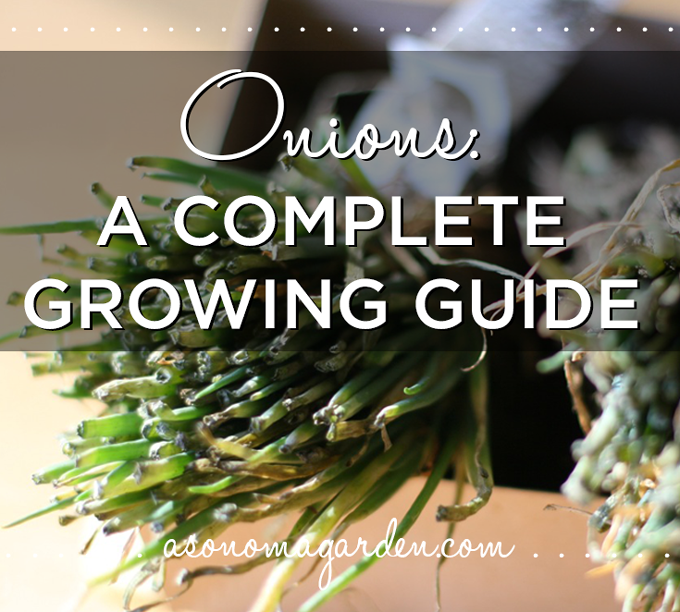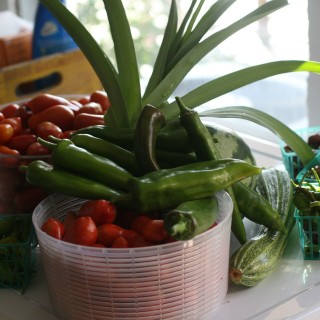We bought our onion sets and got them in the ground this past weekend in between rain showers. I did a whole slew of research about onions this past weekend and thought I’d share what I learned:
The Most Important Thing About Onions
The thing to keep in mind when growing onions is how suitable they are for your growing region. Check in with your local nursery. If they are good, they will only carry onions that grow well in your area. Onions like a determined amount of sunlight each day. Long-day varieties which are suited for the northern latitudes need 14-16 hours of sunlight a day. Short-day varieties need 10-12 hours of sunlight. And Intermediate or Day Neutral need about 12-14 hours. These ‘day-neutral’ varieties can be grown just about anywhere. If your onions are given improper amount of sun they will either bolt too quickly or won’t bulb out at all.
Shelf Life of Onions
Another thing to keep in mind when planting in quantity is thinking about the storage life of your onions. Long-day varieties tend to be the longest keepers, Intermediate-day onions have a moderate shelf life, and short-day onions don’t keep well at all.
Seeds, Sets & Transplants
You can grow onions from seed, sets (small bulbs) or transplants. From our experience, seeds are difficult to get started and transplants are the most expensive option. We usually get sets when they arrive at our nursery in January. We bought 60+ (there were actually more than 60 in our bundle) for $3.99. They are easy to plant and hardly any have died on us.
When to Plant Onions
If you live in a mild-winter area like we do, you can plant seeds in fall through early winter and plant sets anytime in winter. If you live in a cold-weather area, you can start seeds indoors in winter and plant them out as soon as the soil is workable.

What Onions Like
Onions like most veggies, like loose, rich, well drained soil. They like to be placed about 4-5 inches apart in a sunny location. As you can see above, we put a sheet of metal fencing over our raised bed and plant a set in each square. It is an easy way to get your onions (and garlic) perfectly planted. Since onions are fairly shallow rooted you don’t need to water too deeply, but make sure they get watered frequently.
Onions also like to be well feed, so if you aren’t planting them in a spot where you’ve planted green manure, you want to make sure you feed them regularly with an organic fertilizer or mulch them with grass. The bigger and stronger the plants, the bigger the bulbs.
Good Companions to Onions
After we had filled two full raised beds full of onions sets, we still had a pile of left over onions to contend with. We looked at our favorite book Carrots Love Tomatoes and found that we could interplant our onions with any member of the cabbage family, beets, strawberries, tomatoes and lettuce. But that they do not like peas and beans at all. Now our strawberries are peppered with onion starts. Scott reminded me that we put some in the strawberry bed last year and those onions did the best of all last year. We’ll see how they do this year.
How to Harvest
You’ll know when it is time to harvest your onions when the tops have yellowed and have started to fall over. At that point, pull out your onions and leave them on the ground to dry for severals days in the sun. Use the tops of the plants to shade the bulbs to prevent sunburn. Once the tops have dried completely, pull them off the onion bulb, brush of the dirt and store them in a dark, cool, well ventilated area. For us this means in a box in our laundry room. This room doesn’t receive heat and we rarely turn on the light so it seems to be a good spot.
What Onions We Chose
We chose two varieties, Super Star Onion and Red Candy Apple Onion. The Super Star onion is an intermediate length grower, which means that it isn’t particularly sensitive to how many hours of sunlight it receives, which in turn makes it easy to grow just about anywhere. It is a mild, sweet, large onion (up to 1lb each) and they claim that it tastes good raw. Although ever since my last pregnancy I can’t seem to stand the taste of any kind of raw onion, so we’ll see about that. It should be mature in about 100 days, so let’s see how we do. That would put us right around May 5th. Cinco de Mayo. I’ll report back. Although it looks like last year we pulled most of our onions around July 4th.
Our red variety choice was the Red Candy Apple onion. This also is an intermediate or day neutral in terms of sunlight it receives. The name Red Candy Apple comes from the fact that it is so sweet you can eat it like an apple.
Have you planted your onions yet? Do you have any growing tips to add? What varieties do you want to plant?










Excellent post on growing onions! I’m not doing any this year, and probably won’t in the future. I use so many onions I’m not sure I could grow enough. I do grow garlic though and love your idea of using the fencing as a planting guide.
I made your Meyer lemon, arugula and salami sandwich yesterday. Winner, winner, winner! As my husband would say. Although I made his with lettuce since he is not an arugula fan (working on that).
We planted Com Red onions in November (Central Valley) and I have no idea what kind of onion (other than red:) they are. We even emailed the company we bought them from (Peaceful Valley) and they couldn’t help us. So, I guess next year we will have some questions to ask BEFORE we plant!
Also, we used bulbs (with no growth on them) I guess they are the same as your sets except yours have sprouted? Ours are up and look great…but this is only my second year growing onions and I still get confused about what I’m doing. I’m going to assume before I try storing these I will need to find out if they are good keepers or I’ll end up losing them.
I planted my onion seed a couple of weeks ago. Our soil can’t be worked until the middle of March, sometimes not until the end of March. I have cute little seedlings in my trays right now. I’m growing two types. The first is Copra, a long day onion, which is great for our northern area. And Tropea a long-intermediate day red torpedo onion. The first is a fabulous keeper and has a high sugar content, though it is hard to tell since it is an intensely strong onion so sometimes that sugar gets drowned out. Tropea doesn’t keep well at all, but it sounded intriguing.
I’m impressed that you’ve gotten your onions to start from seed Daphne! We’ve never been successful at that in the past, though we try and try. I don’t know why they are so tricky for us to start from seed, so we usually take the cheaters route by going with the starts.
How did you know I was seeking all of this information? So easy to read and all in one post. Thanks so much! I’m looking forward to trying out all your tips
I’m not sure what I do differently. I start them in my laundry room which is cold in the 50°Fs. It is in the high 50°Fs during the day and in the low 50°Fs at night. They sit right by the window that is why the temps are so low (we have been having single digit and below 0 temps at night). I give them 12 hours (long day onions) of artificial light a day, plus they get some sun from the windows. I keep the soil so the top is always moist and plant them 1/4″ below the surface. I always bottom water. I plant in 12 packs, two seeds per cell and after two weeks all but two of the cells have plants. About half only have one. So it isn’t perfect germination, but good enough. Now as long as they don’t damp off I’m set.
Krista – So good to see you…or rather read from you!
Daphne – Thanks for the tips. Maybe we weren’t giving them enough light, we usually would start them outside, probably when the days weren’t long enough yet. We need to set up a space inside for growing seeds under a light.
Awesome treatise on onionage. I’m getting ready to get some Texas 1015’s (sweet) onions into the ground. This is my first year planting them. Thanks for the great info!
You know I have got to get the Tomatoes Love Carrots book! Last year i did my onion sets near some of my bush beans and some near my beets. The beet side did much better.
I prefer using starts also. In my climate the long-day varieties are what i need to use. And this year I’m going to do a lot more.
Hey Compostings! It’s great to hear from you. I thought we had lost you out in blog world. You’re coming back for this growing season, right?
Last year as part of my forray into home gardening, I purchased a nine-cell veggie pack of onions from a local nursery and planted them in a row at one end of one of my raised planter beds (along a 4-foot length). When I harvested, each cell worth were big clusters of onions joined at a common feeder root base. I have no idea if this is how the onions would normally develop (they came out just fine!), or should I have been trying to separate each seedling to a separate planting? When you plant sets, do they each develop into one onion, or do they form multiple?
For this year, I bought some red and yellow onion sets at Harmony in Forestville, though there’s no indication of what actual variety they are (woo, slap “Organic” on it, and apparently nobody cares?). I’m also trying to germinate from seed for a large number of plants this year (something I’m totally new to), including several varieties of onions. Last year’s frosts whacked my hard two times in succession (though had no effect on the Onions, which are frost hardy).
Do you leave any onions (or other crop) to “go to seed”?
Your use of a piece of fencing for spacing is creative. You indicate that you filled two beds — how large are your raised beds? Are you storing any of your harvest, and does that size of planting seem to meet your onion needs, or do you find that you still need to buy at the grocery store?
I’m located just outside of Petaluma. It’s nice to find a site with gardening experiences in Sonoma County.
Hi sstraw – I appologize for taking so long to reply to your comment, but thank you very much for taking the time to write. I don’t know what was going on with your sets. I think that multiple sets were probably put together in each cell. We’ve found when we buy plants from the nursery that sometimes more than one (like lettuce) plant is in each little divider, so I bet that’s what happened to your onions too.
If you do it again this year, I’d pull them out, shake off all the dirt and seperate out each little onion before you plant them.
Harmony is a great nursery! We’ve stopped there a number of times when we go to visit friends in Guerneville. And those frost were tough last year!
We unfortunately do let a number of things go to seed, as you will see if you click on our ‘weed’ category. We do collect some, but since we also plant hybrids from time to time, we can’t use those seeds. We need to get better at not lettting things go do seed because we’ve got this crazy mixture of weeds that are actually edibles. We even have had chard grow in our lawn!
Our raised beds are an average of 4’x8′. I say average because some of them are old fence board nailed together so the sizes are irregular. We did store our onions, but we had neither the room to grow as many as we use in a year, nor were we able to grow the long storage variety, so we ran out of onions in December. That did last us quite a long time though!
Thanks again for your comment, I hope you visit again! It’s always nice to have visitors that are local!
I planted texas supersweet onions today. I guess I’ll get ONE onion for each transplant? Is that how it works?
Hi ailes, Yes, that’s how it works. You’ll get one onion per transplant. Good luck with them.
As for seeds – I have three cells germinating with bunching onions (toyko long white), and they’ve begun sprouting like mad, though as of yet the Yellow Utah Sweet Spanish onions haven’t begun to sprout. Everything is under a grow light and on a heated germination mat.
If I do buy another flat of onions, I’ll see about separating them before planting. I’m trying to migrate away from buying veggies for transplant – the garden seems so much more economically feasable if you start from seed.
Related to onions, I had reasonable success with garlic last year, and have planted more this year, some of which has begun to send shoots out about 1-2″ above the soil already. Last year I simply planted some leftover peeled Christopher Ranch Garlic from a 5lb Costco package (we use a LOT of garlic, but invariably, need to buy a new container before the prior one has been fully used). I repeated the effort this year (along with some other varieties), expanding to an in-the-ground-instead-of-a-raised-bed patch for the Christphers’s stuff.
When it’s dry out, I need to construct a couple more raised beds so I’ll have more space for Alliums.
I really appreciate this post…I just bought some onion starts on impulse at the nursery when my husband got all excited saying “those are the best!!” so I figured I’d get more support in my gardening if I made them grow into big delicious onions…lol…but I already planted so I’ve been trying to figure out where to put them! I have some tomatoes and strawberries in pots as well as a plot of kale/mustard greens…so I figure I’ll spread all my baby onions out in those places. I WAS going to put them along the edge of my garden by the peas…but I won’t be doing that now and I appreciate you letting me know via posting your findings!!
this is one of the best gardening sites i have run into because it is thoroughly informative. i don’t have to dig around anymore!
thanks, awesome job!